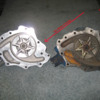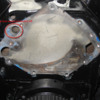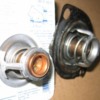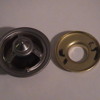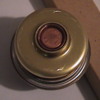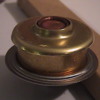quote:
Mine was overheating after I installed the pump. Then we had the thread about it and I modified the pump with a bypass hole and it works fine now.
I am not doubting your experience, but I can see no reason why re-activating that warm-up feature would have any overall effect on the engine's normal-mode running temperature.
With the correct thermostat the entire bypass circuit only comes into play for a few minutes on a cold engine. After that, the coolant warm-up will have fully opened the thermostat, causing the "hat" to block off the hole in the brass restrictor washer, and causing all coolant to flow in its normal manner. That is: pump, radiator, engine block, pump, etc.
When you added the bypass hole to the water pump, did you perhaps also change the thermostat? Or perhaps remove an unknown cooling issue, such as an air pocket?
quote:
As Bosswrench says above, with the bypass blocked, I was getting less cooling. He says 20%.
No, that is not what he said.
He said:
using 'any-old' Ford thermostat with the bypass port still operational will bypass the radiator with an estimated 20% of the coolant, resulting in overheating.To clarify, if you have not blocked off the brass restrictor washer, and if you have a stock-style water pump that still incorporates the bypass port (which is missing on the Weiand), and THEN use a non-Cleveland specific thermostat, you will not have the thermostat "hat" that blocks off the brass restrictor washer upon warm-up. With that washer not blocked-off by the "hat", an estimated 20% of the coolant leaving the water pump is instead free to just return (through that unblocked washer) into the block, leaving only 80% of the coolant to proceed to the radiator.
It is important to note the Cleveland is
unique in that its thermostat has that extra "hat" attached to its moving part. This is not found on any other Ford (or I believe ANY other anything) thermostat. That hat blocks off the brass restrictor washer.
If your warm-up circuit (the water pump port and the brass washer) are still stock, you MUST USE the Cleveland specific thermostat that incorporates the "hat".
If you have blocked off the brass washer, OR use a water pump without the bypass port, you can then use ANY Ford thermostat; which gives you a greater selection of opening temperatures.
2511 has the Weiand with no port, the brass washer is fully blocked, and it has no cooling problems. The Weiand is Quella-modified with a (in theory) flow-increasing round steel plate riveted to the impellers and a Ron Davis triple-pass aluminum radiator. The rest of the system plumbing is stock. I run a non-Cleveland high-flow 180 degree thermostat.
Which in turn opens another topic of whether normal running temperature is a factor of the thermostat opening design. In short, it is not. Your engine, when fully warm and at a steady running speed, will run at the same temp regardless of when the thermostat opens.
For more on all this, view this article at Garth's banzairunnerpantera website:
http://www.banzairunnerpantera...dates_thermostat.htmLarry
'Hat" style on the left


